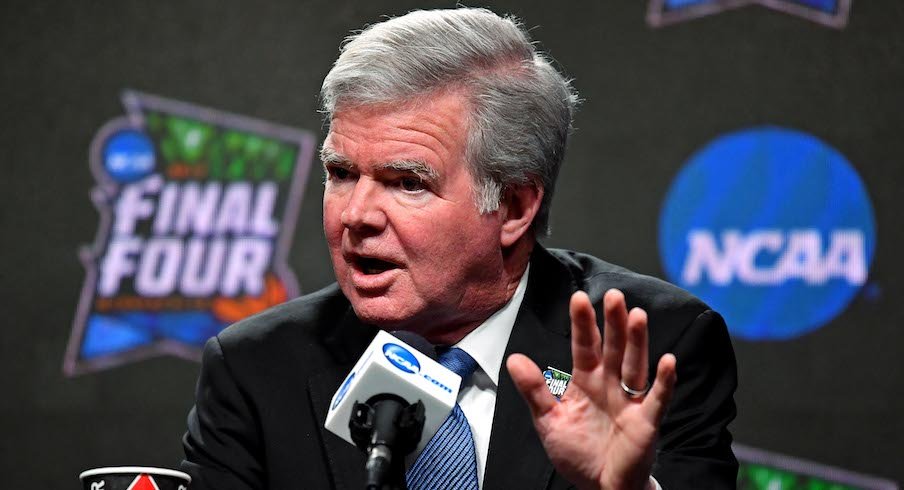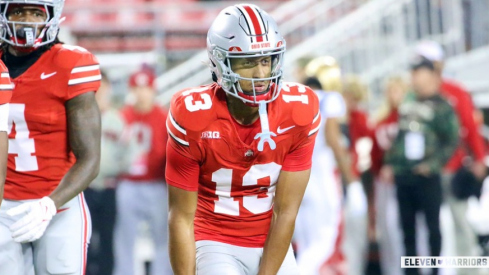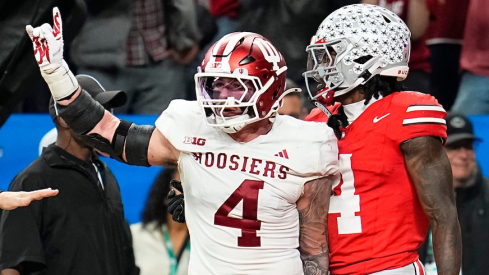What's become clearer by the day will eventually happen became one step closer to actually happening on Wednesday.
The NCAA Board of Governors, a body that is chaired by Ohio State president Michael Drake, put forth its support for rule changes to allow college athletes to profit off of their name, image and likeness. Important steps remain before the alterations are enacted in 2021, but the recommendations would have a significant impact on college athletics.
“It's also really important that in all of this conversation to recognize that what the Board of Governors approve and what the working group put forward is the clear framework within which a lot of detail is still to be developed,” NCAA president Mark Emmert said on Wednesday morning. “That's what the three divisions are working on now. So some of these answers will be ambiguous until all of the details are fleshed down in the coming nine months.”
So, what does this mean? How will it work? What do we know, and what won’t we know?
In an attempt to better understand the news that dropped Wednesday morning, let’s go over what you should know.
What’s the timeline?
The next step will be for the Division I, II and III membership bodies to draft legislative proposals by Aug. 31 and review and revise those proposals by Oct. 31. Once that happens, the NCAA membership will vote on the proposals at its convention in January.
“The NCAA’s work to modernize name, image and likeness continues, and we plan to make these important changes on the original timeline, no later than January 2021,” said Ohio State athletic director Gene Smith, who's also the co-chair of the NCAA’s Federal and State Legislation Working Group.
The changes are expected to take effect for the start of the 2021-22 academic year.
What are the changes?
College athletes could soon be able to profit in ways they never could before. Certain aspects haven’t been finalized at this point, but here are the basics as suggested by the Board of Governors on Wednesday.
What will be allowed
- Athletes will be able to profit off of their name, image and likeness from third-party entities without ties to a school
- They will be able to identify themselves by name, school and sport
- The money made off of name, image and likeness from third parties will be regulated by the NCAA
What won’t be allowed
- Athletes will not be able to use a school’s or conference’s logo or trademark to profit
- Schools will not be able to directly pay students to use their name, image or likeness
- Schools and boosters will not be allowed to use name, image and likeness to recruit athletes
- College athletes won’t be able to be classified as employees or professional athletes
- They’ll still be barred from gaining compensation based on athletic performance or participation
Why is this happening?
The NCAA would have you believe it realized now is the time to allow athletes to profit off of their name, image and likeness. That’s not really true.
Several states put forth legislation over the past year that, if passed, would allow college athletes to make money off of their name, image and likeness. California became the first to do so in September and others followed suit. They essentially forced the NCAA to act in order for everybody across the country to maintain the same rule structure.
“We're a national organization and part of the great appeal of the NCAA is that student-athletes can compete for national championships,” Drake said. “So we have to have a set of rules that are consistent across the country so that people are competing on an equal basis. So that's an important part of what we believe the future needs to maintain.”
How is Congress involved?
Emmert didn’t even make it through his opening statement on Wednesday’s conference call before he mentioned the NCAA is “going to continue to engage with Congress to help navigate these challenges.” In order to have a uniform policy throughout the country, the NCAA intends to get Congress’ help.
“Our report includes a proposed template for Congressional intervention to ensure a uniform national NIL law that would apply to all of our schools and provide a safe harbor that would allow the NCAA to enact and enforce the rules without the threat of continuing a costly litigation,” said Big East commissioner Val Ackerman, who co-chairs the working group with Smith.
Anthony Gonzalez, a former Ohio State wide receiver and current Ohio representative, told ESPN he plans to introduce a federal bill to address name, image and likeness rules within the next month or two.
Is there a cap on earnings?
Nope. Athletes will not have a limit on how much money they can make.
“There's no cap,” Smith said. “It's just a matter of monitoring the right way and making sure that there is not a recruiting inducement in that space.”
How would college athletes earn money?
In many ways.
Would they be able to appear in TV commercials, helping brands sell products? Yes. Would they be able to market products via their own social media channels, becoming Instagram, Twitter, TikTok or Snapchat influencers? Yes. Would they be able to stream themselves playing video games on Twitch or post YouTube videos in order to get advertisement revenue? Yes. Would they be able to hold autograph signings in exchange for money? Yes. Would they be able to sell merchandise? Yes, provided Ohio State’s logo isn’t present.
Provided the general structure of what the Board of Governors put forth gets enacted next year, there’ll be a significant amount of opportunities available that had previously been shut off to college athletes.
The caveat with all of this is that the NCAA will regulate the market to ensure college athletes are making an amount of money in line with what would be fair value. In other words, the governing body would take issue with somebody making $75,000 to sign autographs once for 15 minutes. That would be out of line with what somebody would typically be paid. So, that begs the question: How will something as difficult to value as social media marketing be regulated?
“I think we can't emphasize enough that what the board approved and what the working group brought forward was essentially a green light to explore those kinds of questions,” Emmert said. “There was throughout this process a lot of engagement with the sports marketing world around those questions. I think it's fair to say everybody got to a level of comfort that there could be developed those solutions, and that's what we'll see the members working on over the next nine months.”
How will the NCAA regulate name, image and likeness payments?
In short, it’s yet to be determined. Ackerman said on-campus compliance officials, NCAA staff and potentially a new third-party entity could be involved.
However, there’s a general idea of what won’t be allowed.
“We will look for abnormal activity or abnormal payments to ensure that they're consistent with the level of compensation that should be provided relative to the activity,” Smith said. “There'll be some subjectivity there because that's the market, but the reality is the reasonable, rational and prudent review of that activity will hopefully allow us to determine if it's appropriate.”
Many of the details still remain unknown, though. In the working group’s report, it’s put forth that college athletes might not be allowed to promote alcohol, tobacco or sports gambling since they’re “inconsistent with the NCAA membership's values.” It also put forth the question of whether they should be able to work with shoe and apparel companies “due to their history of encouraging or facilitating recruiting and other rules infractions.”
There’s still a lot to be worked out.
How will this affect recruiting?
Within hours of Wednesday's announcement by the NCAA, Ohio State’s football staff began a full-throated push of what the program can offer in terms of branding and reach. Assistant athletic director for player personnel Mark Pantoni, linebackers coach Al Washington and assistant director of player personnel Weston Zernechel were among those to take to Twitter.
Big city. Best fan base. Endless possibilities. https://t.co/a0kB5IgOQA pic.twitter.com/5KMujazgX1
— Mark Pantoni (@markpantoni) April 29, 2020
No Place like Columbus. No Platform like The Ohio State University https://t.co/gRwlweNZEH pic.twitter.com/yJwQjg1Ro8
— Al Washington (@CoachWash56) April 29, 2020
When it comes to football and their Buckeyes, Buckeye Nation and the people of Ohio dont play! If youre looking to maximize your brand and platform, theres no better place in college football to do so. Peep the #s. No more lies and fake pitches now, you gotta show it pic.twitter.com/XTYvPUueti
— Weston Zernechel (@WestonZernechel) April 29, 2020
Expect to see more of that going forward. Schools will ramp up those types of recruiting pitches.
What the NCAA says still won’t be allowed, though, are benefits intended to induce recruits to attend a specific school.
“It's vitally important to our system of athlete procurement that we maintain some level of integrity and fairness,” Ackerman said. “We believe guardrails on boosters, which is still in development, will help allow us to mitigate the possibility of improper inducements and the potentially harmful involvement of overzealous individuals associated with the schools in both the recruiting and the transfer environments.”
Might this lead to college athletes becoming employees?
No.
The NCAA will not allow that. Emmert and others made that clear during Wednesday morning’s conference call. Money for college athletes must, they stressed, be made from third-party entities.
“There's been a particular concern and interest in maintaining the non-employee status of college athletes, emphasizing that college athletes are students at our colleges and universities, they're not employees of those institutions,” Emmert said. “And everything throughout these recommendations and what the board made very clear was that that's a distinction that needs to be maintained.”
Will the pandemic slow this down from happening?
No, it shouldn’t. Despite the coronavirus pandemic, the Board of Governors has made its recommendations and expects the timeline to remain intact.
“We're in unprecedented and difficult times in the world right now, and we're mindful of the impact of the pandemic on higher education, on college sports and student-athletes,” Smith said. “But we believe allowing college athletes to accept compensation for endorsements and commercial activities will create a system as we move forward. So we're appreciative of the board for approving that report.”
Will the NCAA Football video game return?
As of now, that seems unlikely. Certain steps would have to be taken that aren't imminent at this point. The NCAA’s working group report deemed that it is not recommending any NCAA rule changes that would allow group licenses of name, image and likeness, which would be required for an NCAA football video game to exist.
Ackerman said it would be “unworkable” in college athletics “largely because of the absence of a recognized bargaining agent to manage the terms of group NIL use on behalf of the student-athletes.”
How will this affect Ohio State?
That’s the big, overarching question, and it’s one we’ll be further delving into.
Nothing is finalized yet, but based on the recommendations, it’s difficult to imagine this hurting Ohio State. More than likely, this will benefit the Buckeyes. The ability to earn a profit based off of name, image and likeness will be a boon to schools that...
- Have a massive fan base
- Are located in a big city
- Have a large alumni base already invested in the athletic department
- Aren't overshadowed by pro sports teams in the same city
- Are proactive in building the brands of their athletes
Ohio State checks off just about every box.


